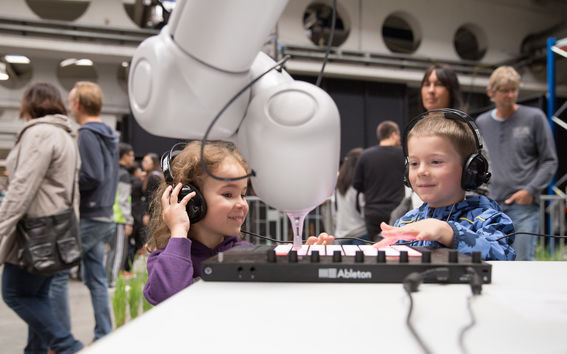Leading European non-formal science education institutions gather to Aalto

On the 18th and 19th of March, experts from leading institutions in science education throughout Europe, together with a diverse group of stakeholders involved in non-formal science learning will meet at Aalto University, to collaborate and ideate solutions for improving science education outside the classroom. The meeting is part of SySTEM 2020, a European research project focused on STEAM learning (Science, Technology, Engineering, Arts & Maths) outside the classroom for children and young people aged from 9 to 20 years old.
During the meeting, SySTEM 2020 project partners and an invited group of stakeholders will work together to identify challenges and generate design solutions regarding different areas of interest in non-formal science learning. Participants will create solutions to foster science learning outside the classroom focused on three major areas of interest: inclusion, engagement and assessment and recognition of learning.
“SySTEM 2020 builds on the idea that meaningful innovation cannot be achieved without closing the gap between research and practice. The adoption of a co-design approach is a good way to involve the people who would be affected by SySTEM 2020 solutions and ensure that researchers and designers understand stakeholders’ views on what are the main challenges, and co-create solutions to support scientific literacy and STEAM thinking in different informal learning contexts”, says Eva Durall, project coordinator at Aalto University.
Mapping STEAM non-formal science education in Europe
At the event, SySTEM 2020 researchers will present some of the key project outcomes. An online repository mapping tool will be presented during the meeting. SySTEM 2020 seeks to influence practice and policy on how to better support and connect science learning outside the classroom. To this aim, the map is crowdsourced, which means that institutions and organisations offering science activities, like science clubs, workshops, and festivals, to name a few, are invited to add information about their activity.
This map, once finalised, would become a handy tool for organisations, researchers and anyone working as non-formal science educators. Joanna Crispell, the Research Projects Coordinator at Science Gallery Dublin--that coordinates SySTEM 2020 project consortium--feels optimistic about its benefits:
“Science Gallery Dublin are thrilled to see the creation of a map to visualise science learning outside the classroom happening across Europe. Such a map doesn’t currently exist for Europe, and through the SySTEM 2020 project we believe that the map will be an important tool for organisations to collaborate, and for researchers studying the field of science learning outside the classroom.”
The co-design workshop will gather expertise from 22 organisations around Europe who work in the field of non-formal STEAM education. The leading institutions of the project are Science Gallery network, Ars Electronica, The European Network of Science Centres and Museums (ECSITE), Waag Society and Aalto University. SySTEM 2020 direct stakeholders are organisations and groups connected to science learning such as science museums, makerspaces and fablabs, science centers, but also individuals like learners, as well as educators and facilitators.
About SySTEM 2020
SySTEM 2020 is a European-wide study into Science Learning Outside the Classroom, which examines how young people learn across Europe. SySTEM 2020 aims to map the diversity of initiatives connected to science education in informal contexts, identify best practices, as well as provide tools to support science learning outside the classroom.
An area of special interest in SySTEM 2020 deals with how to support inclusion and equity in science education. To this end, especial attention is paid to minority groups in science and STEAM education like for instance, girls and women, refugees and migrants and people with disabilities.
SySTEM 2020 is coordinated by the Learning Environments research group, LeGroup, that is part of Media Lab at Aalto University. LeGroup is involved in research, design, and development of New Media tools, as well as their use and application in the field of learning.
For further information:
Researcher and Project Coordinator Eva Durall, Learning Environments Research Group, Aalto University School of Arts, Design and Architecture, [email protected]
Read more news

DeployAI Partners Gather for Heart Beat Meeting in Helsinki
The European DeployAI project's partners gathered for the Heart Beat meeting hosted by Aalto University Executive Education in Helsinki.
Get to know us: Associate Professor Maria Sammalkorpi
Sammalkorpi received her doctorate from Helsinki University of Technology 2004. After her defence, she has worked as a researcher at the Universities of Princeton, Yale and Aalto.
Aalto computer scientists in ICML 2024
Computer scientists in ICML 2024